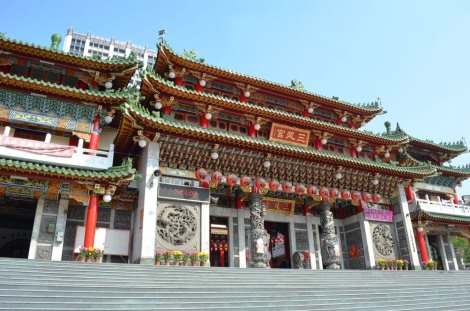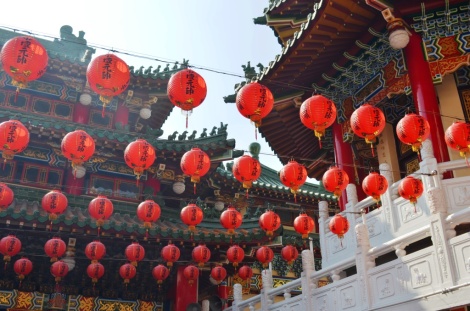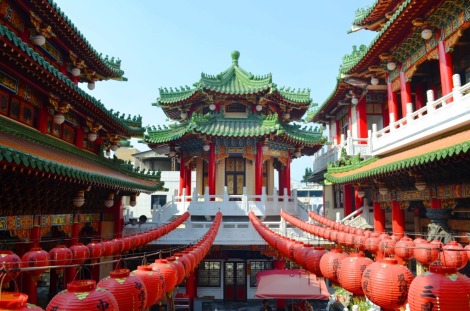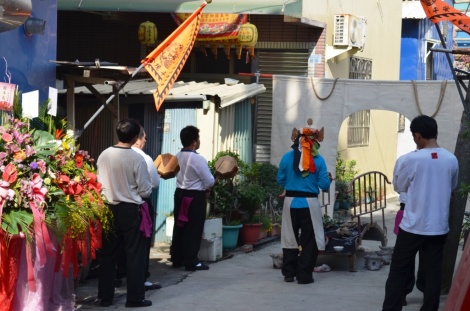17 Feb: We arrived early in the morning to Taipei and had only really finished making our plans on the plane ride over. We decided to head first down to Kaohsiung, which is Taiwan’s second most-populous city and is located on the southern edge of the island, easily accessible by Taiwan’s modern high-speed rail. We checked in to a hotel, found an ATM to draw out some cash, and then went off in search of food. Incidentally, we found perhaps the best French Toast in all of Asia, and the other food we ate at this place (four meals in two days) was also pretty damn good. Anyways…more interesting than French Toast was, we thought, the Kaohsiung Museum of History. Afterwards we spent the afternoon leisurely wandering around town where we caught a little bit of baseball and checked out a local temple.
Instead, we kept walking and found ourselves at a rather large temple, which we were welcomed into:

Outside the temple we saw this; we naturally stuck our head inside. We discovered that this organization, calling itself the Taiwan Civil Government, advocated Taiwan being a territory of the US, as interpreted by their reading of the San Francisco Peace Treaty of 1952. We talked to some of the old men inside, but they oddly did not seem very interested in us.
We (well, let’s be real: R) decided that it was time for more French Toast. Not the typical Taiwanese delicacy, but we had some streetfood throughout our walking tour. Since the French Toast joint was back at the bus station near the hotel, we (R) decided why not? After R scarfed down his order, we left the little cafe and noticed a small gathering taking shape across the street. Never ones to avoid a good protest, we decided to see what the hubbub was all about.

Protesters holding signs (but, politely, not shouting) as business-attired men and women approach the old train station for a meeting with the protestors.

Yep, this looks like something we should check out… definitely not something we would ever see back in Beijing!
So, what we found out was that this seemed to be a routine-level of “protest,” really it was just how local politics plays out. One party (in power) makes a decision about something (in this case it had to do with rail expansion?) and the opposition party shows up to protest anytime there is a press conference or whatnot. Anyways, everyone was very polite.
The rest of the evening we just walked around some more and chatted with people. We ended the evening by the old British Consulate, which sits atop a hill by the university and affords (the hordes of) viewers a nice view of the sunset. Other than that, nothing too exciting.
18 Feb: Today we decided to head over to the Cijin area before we caught a midday train up to Taipei. Cijin is a narrow island which attracts tourists for its beach and its food. We sampled a bit of each. For whatever reason, (perhaps it was too sunny?) the beach was practically empty.
After an hour or so of swimming the Taiwan Straits, we walked over to the less touristy part of the island. We only planned on walking through and finding a bite to eat, but we started hearing some music and followed our ears until we came across some sort of festivity at a local temple we never would have noticed because it was tucked away behind some apartment buildings. Several of the congregants were especially welcoming to us and encouraged us to take lots of photos. We never were able to understand what the ritual we were observing was all about because we couldn’t seem to understand all of the religious terms and names they were using.

In front of the table, a priest (?) performs a series of rituals; at his side are six men who perform the music rites (related to Confucianism perhaps?)
We really enjoyed the fact that multiple people were so energetically trying to explain everything that was going on, and also giving us a very detailed tour of the temple. We felt a little bad because we were only understanding parts of their explanations, but the experience itself was touching.

On the boat ride back from Cijin. The Tuntex Sky Tower was the tallest building in Taiwan until completion of Taipei 101 in 2004. The two side towers support the central section, and is supposedly inspired by the Chinese character 高,which means tall and is also the first character of the city’s name. There is an observation deck toward the top as well.
Once back at the main part of the city, we had some street food, took a bus back to the main train station, stopped for a snack across the street at – yup – the French Toast place, and then headed back up to Taipei. We got in in the early evening, and by the time we got to our hotel, all the tourist spots were closed. No worries, Taipei’s famous night markets were up and kicking even in the rain!
Feb: Today was our last day of travels, so we wanted to make the most of it. We started by going to the National Palace Museum, one of the main reasons for our visit due to how often we would hear about all of “China’s stolen treasures” from folks back in Beijing. This has some of the most valued pieces of art from what was once the Qing Imperial collection. During the Civil War, Chiang Kai-Shek ensured that the choice pieces of the collection were brought to Taiwan. Needless to say, the mainland Chinese aren’t too happy about this, and also needless to say it is the first stop for the hordes of mainlanders who visit. We showed up shortly before 10:00 and were pleasantly surprised to find that there was an almost-free English guided tour that started each day at 10:00. We decided that, when it came to talking about old art, the English tour would be better than reading traditional-script characters or listening to a Chinese tour. So, we hopped on board the English tour. We were very glad we did, as we would have otherwise had almost no way of knowing quite what we were looking at; and the museum is so large (and was so crowded due to the ongoing winter holiday) that we would have been lost in the place without the tour.
About 2 hours was all we could take of ancient Chinese art, and so we decided to not stick around too long after the formal tour was done, although we were very happy to have had the opportunity to see the museum and very much enjoyed our time there. From there we hopped back on a bus toward the metro but jumped off a bit early to grab lunch (a decent Vietnamese-Taiwan fusion place) before walking over to the the Shilin Gardens. The Shilin Gardens encircle the house which had been used by Chiang Kai-Shek and his wife, which now functions as a memorial museum. The building is well-preserved and the interior does a good job of introducing these two historical figures and what their daily life in the house was like. It compares well with the house of Madame Soong Mei-Lin in Beijing, though Chiang Kai-Shek’s house was much bigger, had more signs and explanations, and was used more in a quasi-government fashion for receiving guests, etc., and so there was a bit more history to be displayed.
From there, and by now thoroughly drenched by the unrelenting rain, we headed back toward the part of town where our hotel was. We decided to take buses, and so we ended up seeing other parts of town as well, even decided to stop in and check out the XingtianTemple.
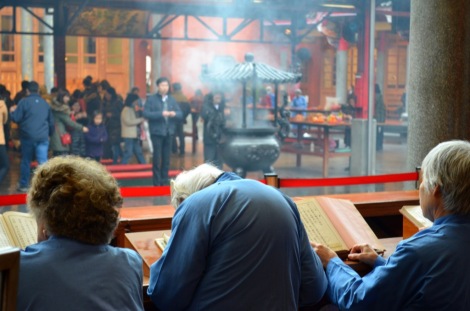
Nuns (not sure if that’s the correct term) read spiritual texts while lay people come to offer prayers.
Nuns (?) assist in the prayer rites by moving joss sticks (incense sticks) in front of and behind each person. The devout were lined up 3 or 4 deep the entire time we were there.

This temple was built in 1967 and was dedicated to a Chinese deity Guan Sheng Dijun, who was a general born in 160 AD. As you can see it is still a very active and lively part of the community.

This was just an ordinary afternoon, not a holiday, and yet despite the rain it was still packed with people. This was quite remarkable to us, given that most of the temples we have visited in the ‘mainland’ are rather devoid of followers and those who do pray are generally there as tourist first, and for religious purposes more as an afterthought or obligation.
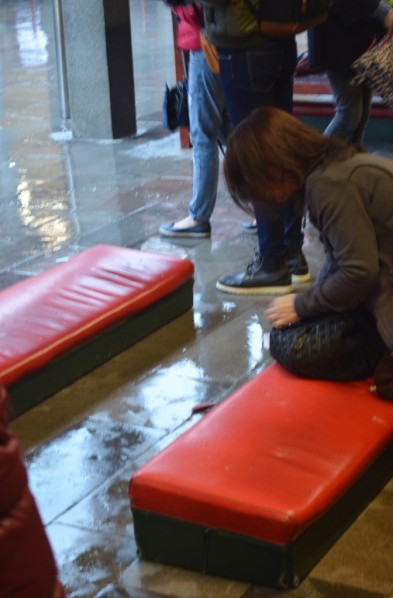
A lady throws two crescent moon shaped pieces of red wood. Depending upon how they fall, she has the answer to the question which she asked immediately before throwing them. This was just one of the methods of divination practiced at this temple.
All in all, we had an incredibly interesting day. The National Palace Museum was certainly interesting and our guide explained the significance of several pieces of art we have seen pictures of or replicas of throughout the past year and a half in China (such as the jade cabbage); the visit to the Generalissimo’s house had some interesting history; and the journey back into town with the stop at the Xing Tian Temple gave us a good glimpse into modern Taiwanese culture. But we weren’t done yet, we still needed to go see Taipei 101. Fortunately, due to the rain, there was no line whatsoever to go up to the viewing platform at the top. Unfortunately, the view pretty limited. It was enclosed, thankfully, but not much of the Taipei skyline was visible. Night had already set in and there were only occasional breaks in the clouds up on the 89th floor. Also, you can see the huge damper suspended below which is pretty cool. We did catch a few good views here and there, and the angle of the windows definitely give you a deep impression of how high up you are, but weren’t really able to get any good pictures.
After such a long day and fulfilling day, we headed back to the hotel and reflected on the past 6 weeks of travel over a late night snack of crackers and wine from the neighboring 7-11. We really enjoyed all of our travels, even the few sick days, rain, blazing heat, and a few ‘closed’ signs, we had still managed to see so much more of Asia-Pacific than we ever would have imagined a few years ago.
20 Feb: We took a cab to catch the first (5:45am) bus from the bus station to the airport, and somewhat reluctantly put our winter travels behind us as made our way back to Beijing. We definitely know that we rushed Taiwan – only 3 days and we only saw parts of 2 cities, but at least we made it (!) and now we have an excuse to go back, which hopefully we will have the chance to do at some point in the not-too-distant future.


